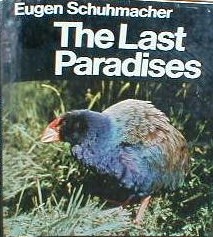The Last Paradises: On the Track of Rare Animals
The Last Paradises On the Track of Rare Animals in German Die letzen Paradiese is the title of a German nature documentary from 1967. It was filmed by Eugen Schuhmacher and Helmuth Barth.
After an animated introduction about the history of extinct species e.g. the quagga, the great auk and the dodo it has gone to 60 countries and territories including Turkey, Spain, Germany, Poland, Australia, Borneo, Chile, Spitzbergen, New Zealand, Papua New Guinea, India, Java, USA, and Peru on all continents and to the most famous national parks. Species like the Hamiltons frog Leiopelma hamiltoni or the Javan rhinoceros were filmed for the very first time. Other sequences including footage of the kakapo, the takahe, the dancing of the redcrowned cranes, the fishing Kodiak bears, the whooping crane, the Asiatic lion, the Komodo dragon, the tuatara, the indri, and the birds of paradise. In particular the filming of the whooping cranes was the result of adventurous circumstances. Because the whooping crane was among the rarest birds in the world in the early 1960s there was no permission to entry the Aransas National Wildlife Refuge in Texas. Fortunately the cranes were provided with food by a plane and during that time the birds came to a wetland in the proximity of the fence. Schuhmacher and Barth planted themselves in a boat in a channel in front of the fence and were able to take some footage from a female and a chicken.
Source: Wikipedia

